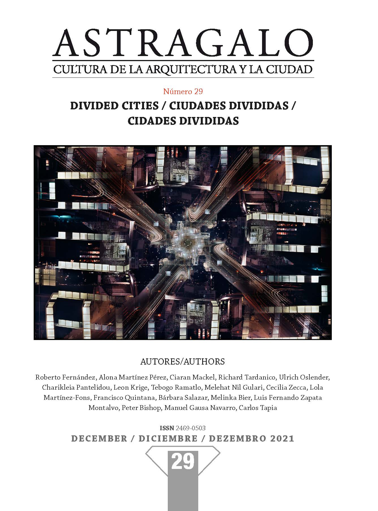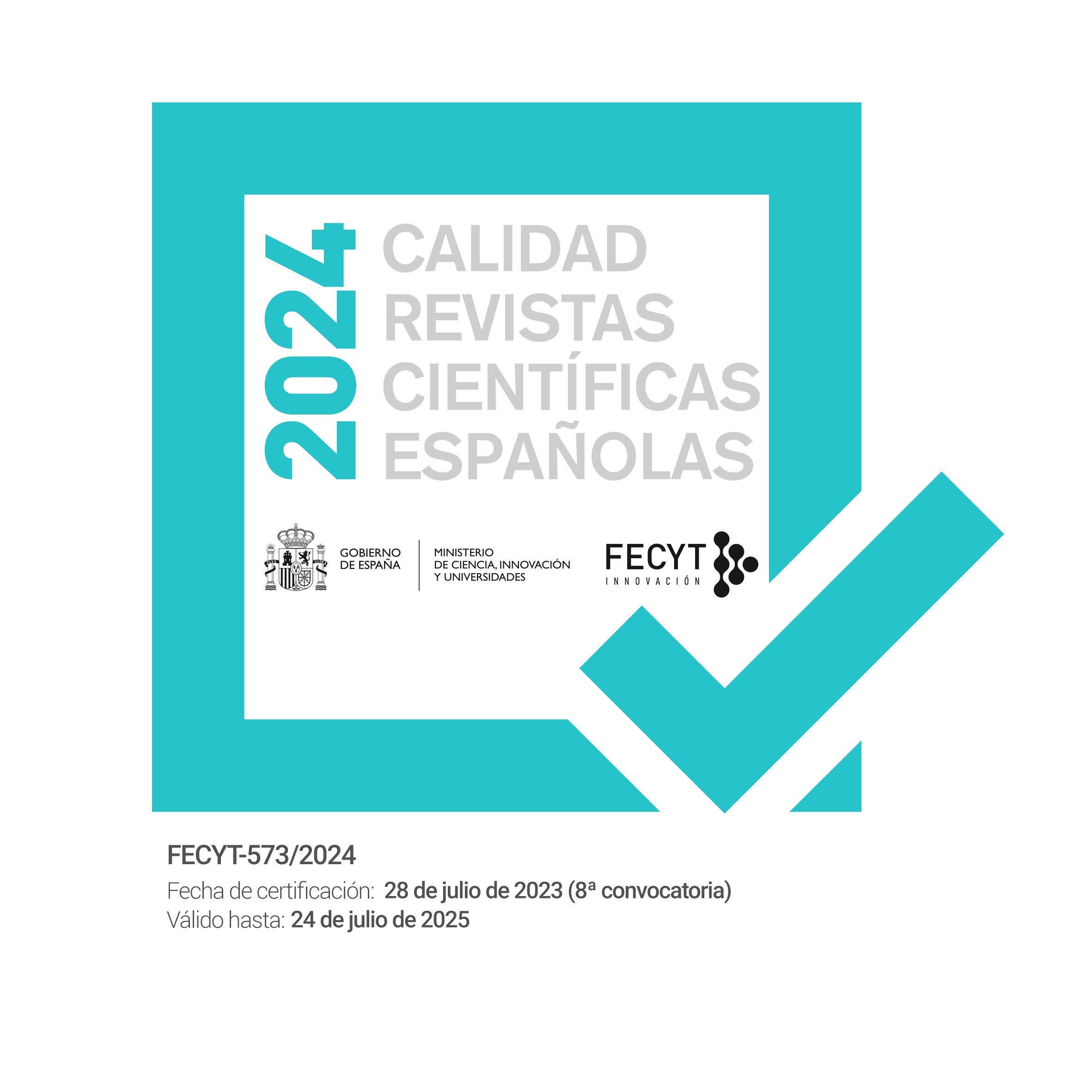Entre territórios opacos contestados e a reapropriação espontânea: Nicósia dividida
DOI:
https://doi.org/10.12795/astragalo.2021.i29.09Palavras-chave:
memória coletiva, cidades contestadas, identidade urbana, urbanismo inclusivo, disputa cipriotaResumo
Este texto discute os conceitos de conflito e fronteira em relação ao lugar e identidade, refletindo sobre narrativas e significados da divisão das fronteiras urbanas e civis, tendo como estudo de caso a sociedade grega e turca dividida que vive em Nicósia. O significado do muro, como expressão explícita de divisão, é discutido, mas também superado ao olhar para seu fechamento e sua permeabilidade, a partir do momento em que as fronteiras fechadas de Nicósia se abriram novamente para a travessia diária.
A investigação argumenta por um caminho alternativo baseado no conceito de Opacidade de Glissant e nos enfoques não essencialistas de Agamben e Nancy, a não-comunidade, para analisar as divisões étnicas profundamente arraigadas e os fragmentos de culturas compartilhadas. Para fundamentar a epistemologia urbana, utilizando os conceitos da vida cotidiana de De Certeau, dois exemplos bottom-up são analisados: Home for Cooperation, um espaço neutro na zona coletiva de unificação e o Movimento Occupy Buffer-zone, que transformou um não-lugar em praça pública por meio do ativismo de base.
O artigo destaca que, para o desenho de um futuro viável em Chipre, é necessária uma aceitação ante essencialista das múltiplas e ecléticas origens do contexto. Neste sentido, o significado tangível e intangível da divisão requer uma mudança -de significado, de delimitação, classificação, separação - para um elemento poroso de equilíbrio e calibração. Os modelos urbanos top-down e a noção de inclusividade foram abalados pela ação temporal de comunidades cívicas, fato que demonstra que a participação coletiva promove a reapropriação do espaço público, alterando a percepção e a experiência da fronteira das diferenças. Isto contribui para teorizar uma prática crítica e reflexiva, ao invés de idealista, de participação no desenho urbano.
Downloads
##plugins.generic.paperbuzz.metrics##
Referências
Agamben, Giorgio. 1993. The Coming Community. Minneapolis: University of Minnesota Press.
Brand, Ralf. 2009. “Written and Unwritten Building Conventions in a Contested City: The Case of Belfast”. Urban Studies. 46, 12: 2669–2689.
Bollens, Scott A. 2012. City and Soul in Divided Societies. London: Routledge.
Cacciari, Massimo. 2004 La cittá. Villa Verrucchio: Pazzini Editore.
Calderon, Camilo. 2020. “Unearthing the political: differences, conflicts and power in participatory urban design”. Journal of Urban Design 25, 1: 50-64.
Carmona, Matthew. 2014. “The Place-shaping Continuum: A Theory of Urban Design Process.” Journal of Urban Design. 19, 1: 2-36.
Cuthbert, Alexander R. 2007. “Urban Design: Requiem for an Era - Review and Critique of the Last 50 Years.” Urban Design International 12 (4): 177–223.
De Certeau, Michel. 1998. The Practice of Everyday Life: Living and cooking. London: University of California Press. Translated by Steven Rendell.
De Vita, Gabriella E., Claudia Trillo and Alona Martinez-Perez. 2016. “Community planning and urban design in contested places. Some insights from Belfast”. Journal of Urban Design, 21:3, 320-334, DOI: 10.1080/13574809.2016.1167586
Dikomitis, Lisa. 2005. “Three readings of a border”. Anthropology Today 21, 5: 7-12.
Hirsch, Marianne. 2001. “Surviving Images: Holocaust Photographs and the Work of Postmemory”. The Yale Journal of Criticism 14, 1: 5-37.
Gaffikin, Frank, Malachy Mceldowney and Ken Sterrett. 2010. “Creating Shared Public Space in the Contested City: The Role of Urban Design. Journal of Urban Design 15 (4): 493–513. DOI: 10.1080/13574809.2010.502338
Gheerawo, Rama. 2016. “Socially inclusive design: A people-centred perspective”. Companion to Design Studies, edited by Penny Sparke and Fiona Fisher, 304-316. London: Routledge.
Glissant, Édouard. 1997. Poetics of Relation. Translated by Betsy Wing. Ann Arbor: University of Michigan Press.
Glissant, Édouard. 2020. Introduction to a Poetics of Diversity. Translated by Celia Britton. Available online: http://public.eblib.com/choice/PublicFullRecord.aspx?p=6230108 (accessed on 15 December 2021).
Goker, Ayse A. 2007. “Being 'Cypriot' in North London: strategies, experiences and contestations”. PhD Thesis, University College London, Department of Anthropology.
Gulari, Melehat N., Asli Börü and Julian Malins. 2011. “Towards an evolutionary understanding on the success of participatory design”. 2011 Design Education for Creativity and Business Innovation Conference edited by Ahmed Kovacevic, William Ion, Chris McMahon,
Lyndon Buck, and Peter Hogarth, 721-726, London, UK.
Hou, Jeffrey, Benjamin Spencer, Thaisa Way and Ken Yoco. 2015. Now Urbanisms. The future City is here. London: Rutledge.
Iliopoulou, Eirini and Pafsanias Karathanasis. 2014. “Towards a Radical Politics: Grassroots Urban Activism in the Walled City of Nicosia”. The Cyprus Review 26, 1: 169-192.
Jones, Reece. 2012. “Spaces of refusal: rethinking sovereign power and resistance at the border”. Annals of the Association of American Geographers 102, 3:685-699. https://doi.org/10.1080/00045608.2011.600193
Karahasan, Hakan. 2005. “Different narratives, different stories: the language of narrative and interpretation”. Journal of Cyprus Studies, 11 28-29: 115-128.
Kliot, Nurit and Yoel Mansfeld. 1997. “The political landscape of partition: The case of Cyprus”. Political Geography 16, 6: 495-521.
Mallinson, William. 2016. Kissinger and the Invasion of Cyprus: Diplomacy in the Eastern Mediterranean. New Castle Upon Tyne: Cambridge Scholars Publishing.
Mouffe, Chantal. 2005. On the Political - Thinking in Action. Abingdon: Routledge.
Nancy, Jean-Luc. 1991. Inoperative Community, Minneapolis, MN: University of Minnesota Press.
Papa, Venetia and Peter Dahlgren. 2017. The Cypriot ‘Occupy the Buffer Zone’ movement: online discursive frames and civic engagement. Oxford: Berghan books.
Peck, Jamie. 2015. “Cities Beyond Compare?” Regional Studies: The Journal of the Regional Studies Association 49, 1–2: 160–182. doi: 10.1080/00343404.2014.980801
Pullan, Wendy and Britt Baillie. 2013.. Locating Urban Conflicts – Ethnicity. Nationalism and the Everyday. London: Palgrave Macmillan.
Relph, Edward. 1976. Place and placelessness. London:Pion.
Rogers, R., 2017. A place for all people: Life, Architecture and the Fair Society.Edinburgh; London: Canongate Books Limited.
Tagliacollo, Emma. 2011. “I confine di Cipro: il “muro” di Nicosia”. Richerche di S/Confine, vol. II, n.1. Available on https://www.repository.unipr.it/bitstream/1889/1546/1/TAGLIACOLLO-confini.pdf Last accessed 15 December 2021.
Webster, Craig. and Timothy, Dallen J. 2006. “Travelling to the ‘Other Side’: the Occupied Zone and Greek Cypriot Views of Crossing the Green Line”. Tourism Geographies, 8 (2): 162-181.
Downloads
Publicado
Como Citar
Edição
Seção
Licença
Copyright (c) 2021 Melehat Nil Gülari, Cecilia Zecca

Este trabalho está licenciado sob uma licença Creative Commons Attribution-NonCommercial-ShareAlike 4.0 International License.
##plugins.generic.dates.accepted## 2022-01-04
##plugins.generic.dates.published## 2022-02-04
- Resumo 357
- PDF (English) 248


















